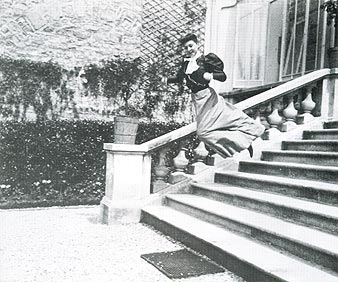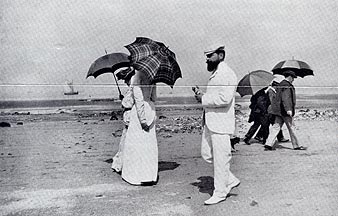Three master photographers
romance the City of Light
By Helen L. Kohen
Art Critic
Lively Arts
Sunday, December 23rd, 1984
The Miami Herald
Art Review
If we share visions of a glorious Paris, and of its seductive lifestyle, we might hold the photographs of three living artists responsible: Not since the days of Eugene Atget has the City of Light been romanced with such affecting light as that cast by Andre Kertesz, Jacques-Henri Lartigue and Robert Doisneau.
In a kind of tribute to those venerable elders, and as a triple treat for all of us would-be Parisians, ArtSpace/Virginia Miller Galleries is currently featuring works by the three in their third Annual Photography Exhibition. It is a show so rich in memorable images that it leaves a head reeling for hours.
The most striking of the photographs come from Lartigue, 90, who has surely enjoyed one of the longest creative lives in photography. Behind a camera since 1902, when he took his very first picture unaided, his early works have become emblems of the high times that World War I banished from the European scene forever.
|
 |
Jacques-Henri Lartigue, 40, Rue Cortambert
Silver Print, 12 x 16 inches
|
 |
Jacques-Henri Lartigue, Villerville/Cousin Caro
and Mr. Plantevigne, Silver Print, 1906
|
|
Well-born and secure from childhood, Lartigue made a fetching sight as a boy and young man, pointing his camera, begging family and strangers to hold still. Elegant women on the boulevards complied, daredevils in cars and planes were charmed by his attentions, and even a storm on the beach at Nice subsided long enough for him to make a remarkable document of its fury.
Lartigue was little known in this country before the ’60s, when his photographs were first shown at New York’s Museum of Modern Art. It was strange timing, for by then he had been a painter for years. He thought his career in photography was behind him, but no one, especially not his fellow Frenchmen who think him a national treasure, would allow his pictures to fade.
They are certainly more than charming reminders of a bygone era. Now especially, they look to be prefigurations of contemporary works-works thought to be the signature efforts of several leading artists. For example, before William Wegman and his dog Man Ray, Lartigue involved his cat in a ball-throwing antic; before Cecil Beaton, he used a beautiful woman and a mirror effectively; before Richard Avedon, his models jumped for his camera; and before Diane Arbus, he photographed a set of grown-up twins with an eye cocked to the surreal.
There is much more than Lartigue’s astounding career to view in this show. The compelling compositions of Kertesz capture Paris at a time closer to our own. Currently featured at a show at the Lowe Art Museum, the photographs of this nonagenarian have been treated recently in this column. Still, there is hardly an overlap between the shows. New in the ArtSpace/Virginia Miller Galleries show is an image of Paris rooftops, shot through a broken camera plate, and a view of the Eiffel Tower that makes it seem a cousin to Claes Oldenburg’s monumental baseball bat.
If Kertesz is an intuitive artist, Doisneau follows a definite mission in his picture-taking. He would substitute the idea of the photographer as a “hunter after images” for that of the fisherman He waits. Eventually the “unimaginable” comes along, and it is precisely that image that he seeks. While there are certain posed pictures in this group—including a funny sequence with a cellist friend—he is most amused by the things that surprise him in the streets.
Humor is important to Doisneau. The 72-year-old photographer had the sort of hard childhood that leaves as a legacy a desire for liberty and a wish to play. His work is full of that spirit, which is best exemplified by the famous Un Regard Oblique (1948), in which a man and wife survey the window of an art gallery. Her face reflects a keen interest in a painting on an easel, while his eye is turned to the nude on the wall. Even Doisneau's posed portraits have a humorous side. Picasso is seen at a table, his genius hands replaced by 10 tiny well-arranged baguettes, and Leger, standing in front of one painting and behind another, appears to be his own central figure in one enormous complex work.
This is one of those superior shows that enthusiasts of photography would regret missing. Don't do it: Exhibits like this come around too seldom.
top
|
